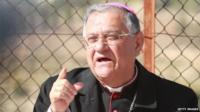
Palestinians are celebrating after Israel's Supreme Court rejected a plan to route the West Bank barrier through a beauty spot near Bethlehem.
A long-running legal campaign against the proposal had drawn the attention of Pope Francis.
The Israeli government wanted to build a section of its separation barrier between church properties in the scenic Cremisan Valley.
Fifty-eight Christian families would have been cut off from their land.
"This is a victory for everyone," the Latin Patriarch of Jerusalem, Fuad Twal said at a news conference. He suggested the announcement had special significance in the Holy Land ahead of Easter.
"I am celebrating the resurrection before the Calvary [Good Friday] tomorrow," commented local priest, Father Ibrahim Shomali, who led weekly prayers under olive trees in the valley.
"We have been suffering for nine years because we feared we'd lose our land. It wasn't easy to get this decision so we thank God."

Construction of the barrier began in 2002, during the second Palestinian intifada or uprising, following a wave of suicide bombings.
Israel said it was an essential security measure to prevent attacks.
However, Palestinians see it largely as a land grab because much of it was built inside the occupied West Bank.
Jewish settlements and additional land have been left on the Israeli side.
Settlements are seen as illegal under international law, although Israel disagrees.
In the Cremisan Valley, Israel's defence ministry argued it was seeking added protection for the settlements of Har Gilo and Gilo. Israelis view these as Jewish neighbourhoods of Jerusalem.
The barrier would have cut between a 19th Century monastery and winery run by Salesian monks - putting them on the Jerusalem side - and a neighbouring convent and primary school run by nuns.
The Israeli authorities had said there would be access between the sites and for Palestinians trying to reach their land through gates operated by soldiers.
Locals grow olives and fruits in the green, terraced valley and visit it for recreational purposes such as hiking and barbecues.
When Pope Francis visited the Holy Land last year he met some of the Palestinian families involved in the legal case and promised to follow up on it.
The Israeli court has now told the defence ministry to look into an alternative route for the barrier that is less disruptive for the community.
It said the two church sites should remain connected on the Palestinian side of the barrier.
In January, the High Court halted proceedings to build the separation barrier in Battir, also in the Bethlehem district.
The village had been recognised as a UNESCO World Heritage Site last year because of its ancient agricultural terraces and irrigation system.
However Israel's separation barrier has been constructed around the village of al-Walaja, which lies between the Cremisan Valley and Battir.
Anda sedang membaca artikel tentang
West Bank barrier plan rejected
Dengan url
http://worldartikelku.blogspot.com/2015/04/west-bank-barrier-plan-rejected.html
Anda boleh menyebar luaskannya atau mengcopy paste-nya
West Bank barrier plan rejected
namun jangan lupa untuk meletakkan link
West Bank barrier plan rejected
sebagai sumbernya
0 komentar:
Posting Komentar